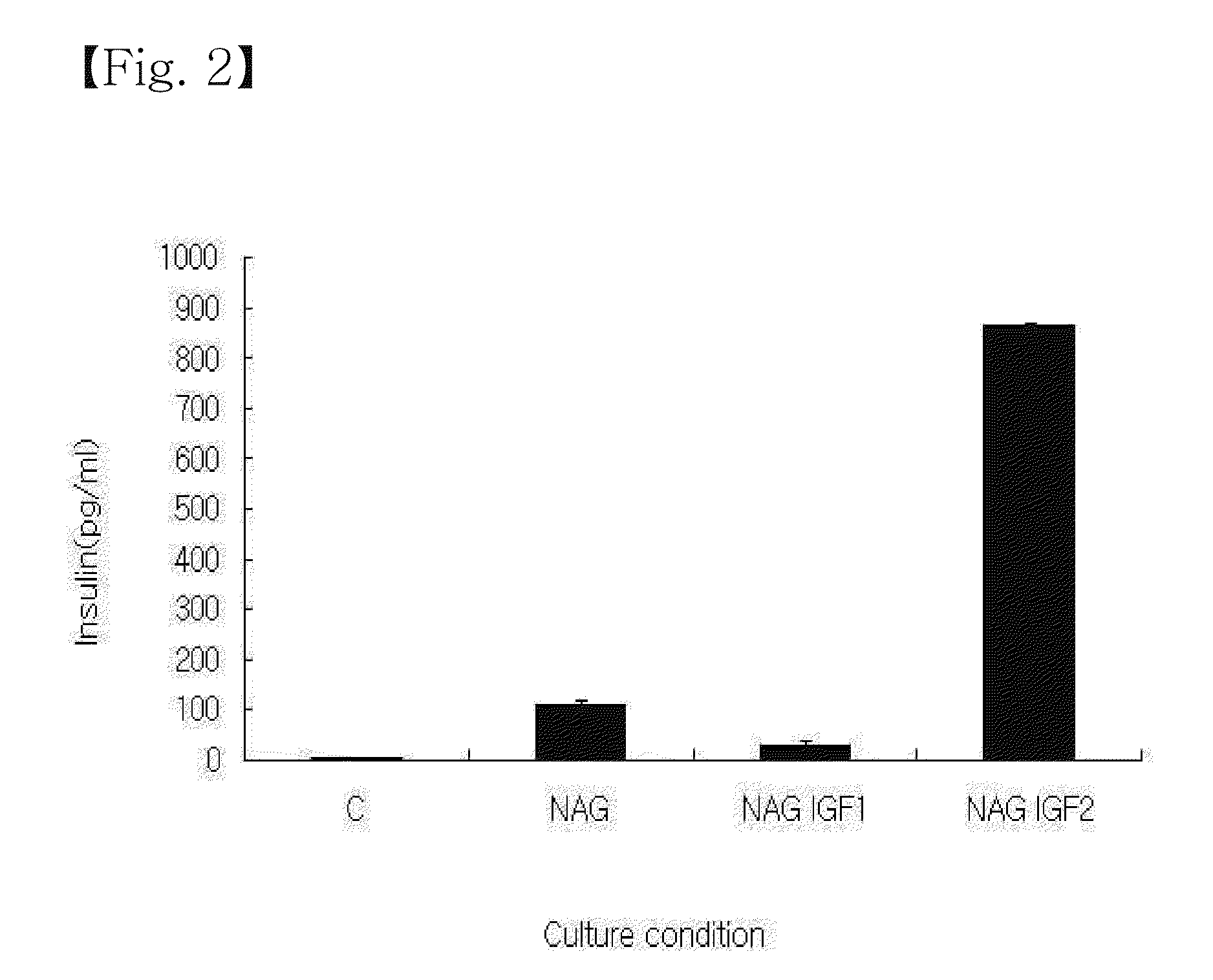Method for the differentiation of human adult stem cells into insulin-secreting cells
a human stem cell and insulin-secreting technology, applied in the direction of skeletal/connective tissue cells, drug compositions, metabolic disorders, etc., can solve the problems of increasing blood sugar level, unable to fundamentally cure the disease of insulin use, and many histological limitations, and achieve high-efficiency effects
- Summary
- Abstract
- Description
- Claims
- Application Information
AI Technical Summary
Benefits of technology
Problems solved by technology
Method used
Image
Examples
example 1
Isolation of Stem Cells
[0035]The adipose tissue, surgically excised from the subcutaneous layer around the eye in a plastic surgery hospital with the patient's permission, was treated at 37° C. for 30 min with a 0.075% collagenase type 1 solution and then with the same volume of a fetal bovine serum-supplemented medium as that of the collagenase solution to terminate the enzyme activity. After centrifugation, the cell pellet thus formed was washed twice with a culture medium and incubated in DMEM-LG supplemented with 10% fetal bovine serum.
example 2
Stem Cell Culture
[0036]The stem cells obtained were cultured for 21 days in a differentiation inducing media. For this, first, the cells were seeded at a density of 5×103 cells / well on collagen-coated 48-well plates to which a medium containing 25 mM glucose (DMEM-HG), supplemented with 10% fetal bovine serum, 4 nM activin A, 10 nM glucagon-like peptide-1 and 20 ng / ml fibroblast growth factor-2, was added before incubating for 7 days. Thereafter, the cells were further cultured for an additional 14 days in a medium containing 5.5 mM glucose (DMEM-LG), supplemented with 10% fetal bovine serum, 10 mM nicotinamide, 4 nM activin A, 10 nM glucagon-like peptide-1, and 50 ng / ml insulin-like growth factor-1 or insulin-like growth factor-2.
[0037]During incubation, the media were changed with fresh ones at regular intervals of 3-4 days. After incubation for a total of 3 weeks, the differentiation of the cells was examined as follows.
example 3
Morphological Changes of Cells after Differentiation
[0038]Stem cells were isolated from the subcutaneous fat around the eye and cultured, and the morphological changes thereof were monitored. While remaining unchanged in morphology upon incubation in media free of growth factors and cytokines, the stem cells were observed to undergo a morphological change to a round form when they were treated with growth factors and / or cytokines such as nicotinamide, activin A, and glucagon-like peptide-1 or insulin-like growth factor-1 or -2 (FIG. 1). On week 3 after induction for differentiation, the cells became round in morphology, forming cell clusters.
PUM
| Property | Measurement | Unit |
|---|---|---|
| Time | aaaaa | aaaaa |
| Time | aaaaa | aaaaa |
| Fraction | aaaaa | aaaaa |
Abstract
Description
Claims
Application Information
 Login to View More
Login to View More - R&D
- Intellectual Property
- Life Sciences
- Materials
- Tech Scout
- Unparalleled Data Quality
- Higher Quality Content
- 60% Fewer Hallucinations
Browse by: Latest US Patents, China's latest patents, Technical Efficacy Thesaurus, Application Domain, Technology Topic, Popular Technical Reports.
© 2025 PatSnap. All rights reserved.Legal|Privacy policy|Modern Slavery Act Transparency Statement|Sitemap|About US| Contact US: help@patsnap.com



